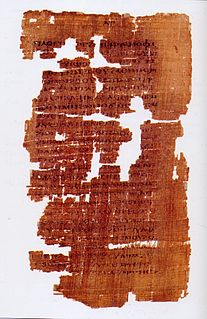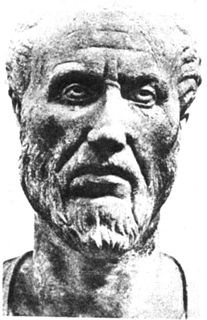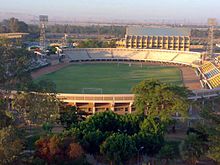
Nag Hammadi is a city in Upper Egypt. It is located on the west bank of the Nile in the Qena Governorate, about 80 kilometres north-west of Luxor. It had a population of close to 43,000 as of 2007.
The Nag Hammadi library is a collection of early Christian and Gnostic texts discovered near the Upper Egyptian town of Nag Hammadi in 1945.
Papyrology is the study of ancient literature, correspondence, legal archives, etc., as preserved in manuscripts written on papyrus, the most common form of writing material in the ancient civilizations of Egypt, Greece, and Rome. Papyrology includes both the translation and interpretation of ancient documents in a variety of languages and the care and preservation of rare papyrus originals.

The First Apocalypse of James is an early third century Gnostic apocalypse.

The Letter of Peter to Philip is a gnostic Christian epistle found in the Nag Hammadi Library in Egypt. It was dated to be written around late 2nd century to early 3rd century CE and focuses on a post-crucifixion appearance and teachings of Jesus Christ to the apostles on the Mount of Olives, or Mount Olivet.
The Epistle of Eugnostos is one of many Gnostic tractates from the Nag Hammadi library, discovered in Egypt in 1945. The Nag Hammadi codices contain two full copies of this tractate. The epistle was a familiar literary convention of Antiquity; it is not to be supposed that this essay is an actual letter written by a man named Eugnostos.
The Thought of Norea is a brief Sethian Gnostic text. The main surviving copies come from the Nag Hammadi library. The Thought of Norea is sometimes considered to belong to the New Testament apocrypha. It is one of the shorter texts of the Nag Hammadi collection and is estimated to have been written In the second century C.E.

Gnosticism refers to a collection of religious groups originating in Jewish religiosity in Alexandria in the first few centuries CE. Neoplatonism was a school of Hellenistic philosophy that took shape in the 3rd century, based on the teachings of Plato and some of his early followers. While Gnosticism was influenced by Middle Platonism, neo-Platonists from the third century onward rejected Gnosticism.
Mohamed Abdelwahab was an Egyptian footballer. He played in the defensive left back position. He was an important part of the Egyptian squad that went on to win the 2006 African Cup of Nations. He died during training with his club El Ahly on 31 August 2006.
On the Origin of the World is a Gnostic work dealing with creation and the end time. It was found among the texts in what is known as the Nag Hammadi library, in Codex II and Codex XIII, immediately following the Reality of the Rulers. There are many parallels between the two texts. The manuscript does not have a title, but scholars have dubbed it “On the Origin of the World,” because of what it describes. It is estimated to have been written sometime near the end of the third century. While the author is not mentioned, he or she seems to have been interested in expressing a Gnostic understanding of the world’s conception. In particular, it rethinks the entire story of Genesis, and positions Yaldabaoth as the creator of the world, fulfilling the role of God in Genesis. Furthermore, the Serpent in the Garden of Eden is depicted as a hero sent by Sophia, the figure of wisdom, to guide mankind towards enlightenment. It expresses one approach to the creation and end of the world. Other myths found within the Nag Hammadi collection have varying explanations and details.

Aluminium is an Egyptian football club based in Nag Hammâdi.

Hamrah Dom is a small village in Upper Egypt. It is situated near the city of Qena, about 80 kilometres north-west of Luxor.

Anba Mikhail, was the Elder Metropolitan of the Holy Metropolis of Asyut (Lycopolis), (Hieracon, and of the Coptic Orthodox Church of Alexandria and was the Abbot of the Monastery of Saint Macarius the Great, in Scetes, Lower Egypt until early 2009, when he decided to resign this responsibility due to his failing health and also due to the demise of Matta El-Meskeen, the Chief Hegumen in-charge of the Monastery of Saint Macarius the Great in 2008.

Pahor Labib was Director of the Coptic Museum, Cairo, Egypt, from 1951 to 1965 and one of the world leaders in Egyptology and Coptology.
The Nag Hammadi massacre was a massacre of Coptic Christians carried out on the eve of 7 January 2010, in the Egyptian city of Nag Hammadi. The massacre occurred at the hands of Muslim gunmen in front of the Nag Hammadi cathedral, as Coptic Christians were leaving the church after celebrating the midnight Christmas mass. The massacre resulted in the murder of seven Copts and one Muslim bystander. Nine other Copts were confirmed to be wounded, and two Muslims were reportedly wounded in the attack.

Papyrus Oxyrhynchus 1 is a papyrus fragment of the logia of Jesus written in Greek. It was among the first of the Oxyrhynchus Papyri discovered by Grenfell and Hunt. It was discovered on the second day of excavation, 12 January 1897, in the garbage mounds in the Egyptian town of Oxyrhynchus. The fragment is dated to the early half of the 3rd century. Grenfell and Hunt originally dated the fragment between 150-300, but "probably not written much later than the year 200." It was later discovered to be the oldest manuscript of the Gospel of Thomas.
Jabal al-Ṭārif is an archaeological site in the cliffs along the Nile, located in Egypt's Qena Governorate, about 5 km north of Nag Hammadi, and about the same distance west of Hamrah Dawm.
Nag Hammadi Codex XIII is a papyrus codex with a collection of early Christian Gnostic texts in Coptic. The manuscript is dated to the 4th century.
The 2013 Egypt Cup is the eighty-first season of the Egypt Cup since its establishment in 1921. A total of 48 teams contested for the Cup.







